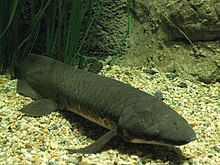| Lungfish Temporal range:
| |
|---|---|

| |
| Queensland lungfish | |
| Scientific classification | |
| Domain: | Eukaryota |
| Kingdom: | Animalia |
| Phylum: | Chordata |
| Clade: | Sarcopterygii |
| Clade: | Rhipidistia |
| Clade: | Dipnomorpha Ahlberg, 1991 |
| Class: | Dipnoi J. P. Müller, 1844 |
| Living families | |
|
Fossil taxa, see text | |
Lungfish are freshwater vertebrates belonging to the class Dipnoi.[1] Lungfish are best known for retaining ancestral characteristics within the Osteichthyes, including the ability to breathe air, and ancestral structures within Sarcopterygii, including the presence of lobed fins with a well-developed internal skeleton. Lungfish represent the closest living relatives of the tetrapods (which includes living amphibians, reptiles, birds and mammals). The mouths of lungfish typically bear tooth plates, which are used to crush hard shelled organisms.
Today there are only six known species of lungfish, living in Africa, South America, and Australia, though they were formerly globally distributed. The fossil record of the group extends into the Early Devonian, over 410 million years ago. The earliest known members of the group were marine, while almost all post-Carboniferous representatives inhabit freshwater environments.[2]
- ^ "ITIS - Report: Dipnoi". www.itis.gov. Retrieved 13 March 2023.
- ^ Kemp, Anne; Cavin, Lionel; Guinot, Guillaume (1 April 2017). "Evolutionary history of lungfishes with a new phylogeny of post-Devonian genera". Palaeogeography, Palaeoclimatology, Palaeoecology. 471: 209–219. Bibcode:2017PPP...471..209K. doi:10.1016/j.palaeo.2016.12.051. ISSN 0031-0182.